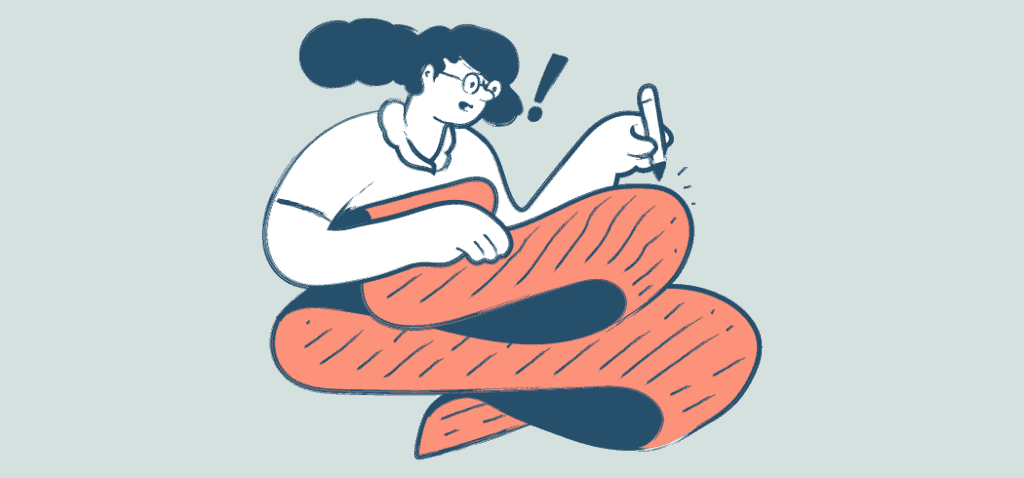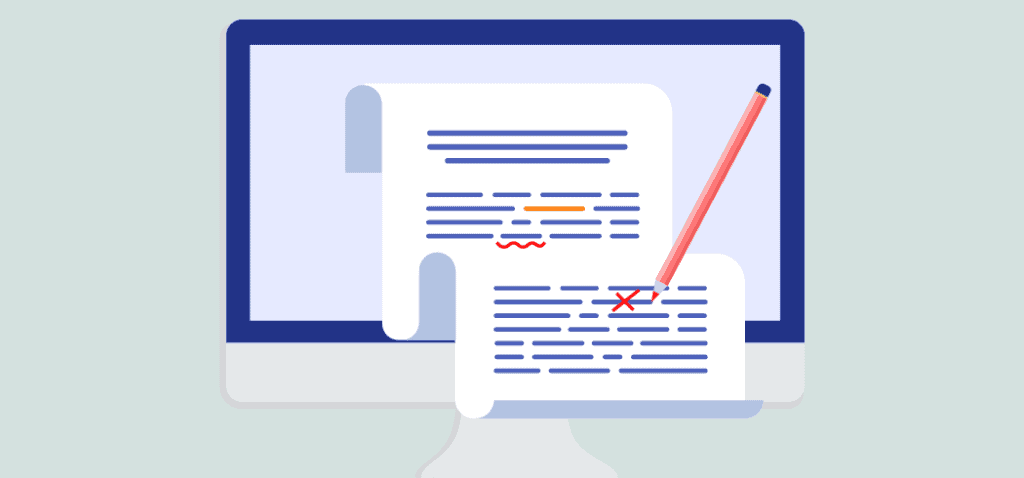Many people use the terms “proofreading” and “revising” interchangeably, but they are two completely different activities. One tackles surface-level errors, while the other concentrates on the bigger picture.
This proofreading vs. revising will compare the differences between the two stages of the writing process. Find out which service you need and which one comes first.
Revising vs. Proofreading
Revising and proofreading both aim to enhance the quality of your writing. But their focuses differ. Revising refers to logical and structural changes, while the goal of proofreading involves correcting typos, grammatical errors, and formatting issues.
Also, revision deals with straight up changing and perfecting, whereas the proofreading process leaves the original content and places proofreading marks where changes are needed. Let’s go in-depth about their differences.
Proofreading

Proofreading means looking at a paper line by line to scan for mechanical errors like typos and grammar mistakes. Before publishing or submitting the text, a proofreader must catch misspellings, grammar issues, stylistic mistakes, and improper formatting. There are tons of effective proofreading strategies, but most proofreaders have a checklist within reach when doing the job.
Some consider proofreading as a part of the revision process. Others see it as a component of editing. Some experts think proofreading is a separate process and isn’t a subset of any of these steps.
Proofreading requires you to watch out for:
- Typographical errors.
- Misspellings.
- Basic grammatical mistakes (improper verb tenses, overuse of adverbs, etc.).
- Punctuation mistakes.
- Citation mistakes
- Plagiarism
- Layout and format of the paper.
Some proofreaders also go in-depth into grammatical mistakes and syntax. They consider the sentence variety, sentence construction, and tone inconsistencies.
Proofreading is essential because it ensures everything is perfect before the final copy. An excellent proofreader spots mistakes that previous editors may have missed.
Revising
The aim of revision includes massive, logical changes to your paper’s structure and content. It focuses on the argument, supporting details, sequence, and overall structure of your essay. A revisor checks the following aspects of writing:
- Style and sequence of sentences and paragraphs.
- Articulation of the information.
- How you present and dive deeper into your evidence.
- The overall organization of the article.
The act of revising may also include making sure the paper adheres to a specific convention of academic writing. Some revisors also check the tone of writing. But all professional revisors watch out for gaps and holes in papers, especially research papers.
It’s best to have a revision plan before you start so you don’t lose track of what’s been done. And, especially authors, expect many rounds of revision and solid proofreading before your manuscript is ready for publication.
If you get lost in your writing, there’s a huge chance your readers will too. A straightforward way to avoid this problem is to use transitional devices like “as previously mentioned,” “consequently,” and “as a result.”
It’s just human error to want to use these terms to start sentences, but they’re stylistic errors and generally frowned upon by most editors. To avoid substantial revisions and time polishing the first draft, it’s best to avoid them altogether.
What Comes First, Proofreading or Revising?
The editing process is vast; revising comes first before proofreading because revisions will eliminate some of the biggest issues. You don’t want to revise and move to proof only to come back to revising again. Revise to iron out surface-level mistakes as well as deep issues, then proof.
Proofreading is always the last step when writing a book, blog post, or business paper. After all, a proofreader’s job is to look for mistakes the editor missed.
Another reason revising should come first is that you’ll commit more misspellings and grammatical errors. You’ll unintentionally err as you fix the flow of your paper and its logical structure.
For example, you might miss a comma while changing your sentence flow. It’s also possible for the writer to accidentally misspell a word while fixing the sequence of their story.
Typographical errors, incorrect punctuations, and capitalization issues always come last. Fixing these tiny mistakes is like polishing your already-perfect paper just to make sure.
Many freelancers and companies offer an all-in-one service if you’re on a budget. These professional English editing services can correct the logical reasoning of your paper and its mechanical errors.
Importance of Proofreading and Revising in Writing

Proofreading and revising are two essential steps in writing before publishing or submitting them. The two separate processes ensure you never miss a single error on your written document, both minor and bigger-picture.
When you engage in revision, you learn how to challenge your own ideas. You start evaluating your supporting details and check if they are relevant to your thesis statement.
Revision also helps you check the logical structure of your written document. It prevents readers from getting confused about the sequence of your arguments.
For example, revisors double-check if the audience understands your second point based on the information stated on the first point. They also see to it that there’s a smooth transition between each idea through transitional words and headings.
Proofreading is also crucial, so you don’t lose sight of tiny mistakes. No matter how brilliant your argument is, it won’t make an impression if there are many misspelled words. Readers won’t also enjoy reading it due to poor formatting.
Any paper that undergoes extensive revision and proofreading has a higher chance of success. If you revise and proofread your academic essay, your probability of getting a high score is high. The same is true for posts that aim for higher SEO rankings.
What are the Differences Between Revising and Editing?
One big difference between revising and editing is their focus on different aspects of your writing. Revising looks at the bigger picture of your paper, including your arguments, information, and supporting details.
Editing is not concerned with these substantial structural changes. Instead, it focuses on tinier issues like sentence structure and phrasing. These are also known as “local changes.” This is also the second step to improving your writing.
After revising, you edit your paper to ensure the message is clear, smooth, and concise. Editing in English can include removing passive voice sentences and comma splices. Run-on sentences, repetitive phrases, and weak adverbs are also eliminated here.
If you’re an editor, your job is not to check the flow and strength of your ideas or story. Just read each sentence and check if it makes sense. Did the writer spell the words correctly? Is the tone consistent? Is the writing style appropriate?
As with editing and proofreading, editing and revising may overlap. For instance, developmental and structural editors also focus on the bigger picture aspects of writing. They make changes to the elements of the story, main idea, and other similar features.
Learn the Differences Between Proofreading and Revising
Proofreading and revision are necessary steps you shouldn’t skip if you want to produce the best quality writing without spelling mistakes or grammatical errors. Remember that revising includes big, structural changes, while proofreading focuses on surface errors.
After spending time writing, you should revise your paper first. Then, perform the act of proofreading last.
